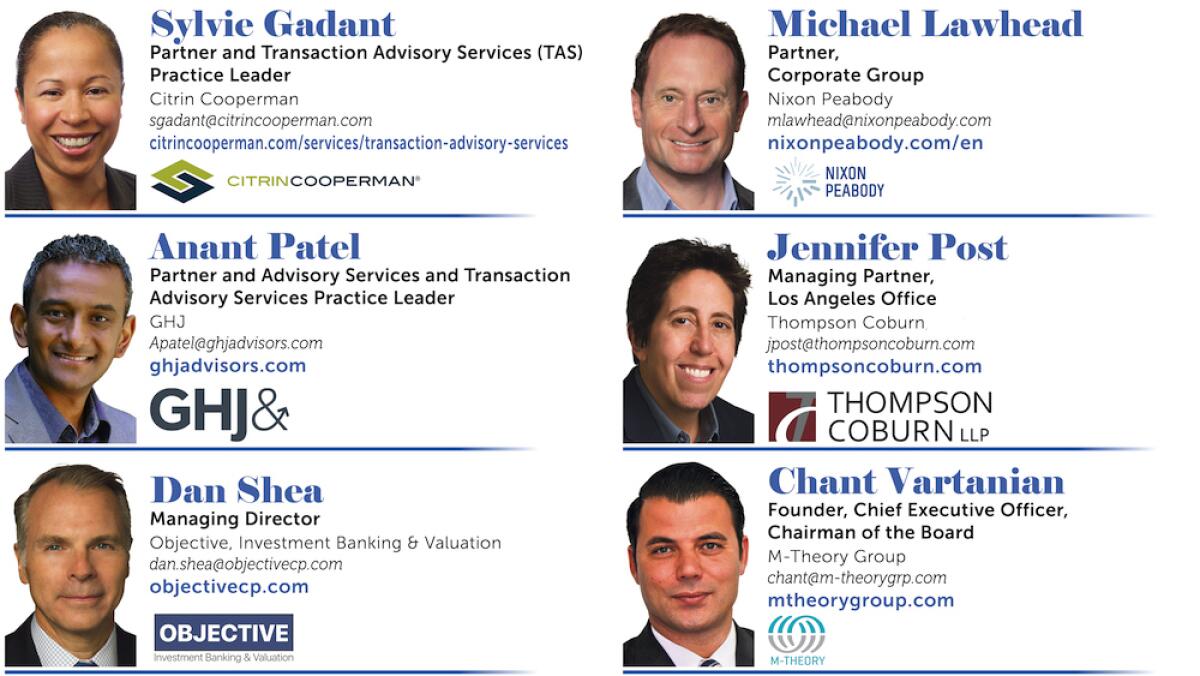The Latest in Private Equity and M&A Strategies

- Share via
The Private Equity and M&A Strategies panel is produced by the L.A. Times B2B Publishing team in conjunction with Citrin Cooperman; GHJ; M-Theory Group; Nixon Peabody; Objective, Investment Banking & Valuation; and Thompson Coburn.
After the unprecedented changes that businesses in every sector had to make last year, new factors have arisen in terms of managing private equity or taking the plunge for a merger or acquisition. The economic climate has also forced changes to the way companies do business and the way they approach fiscal needs.
To address both these issues and the latest trends in private equity management and the M&A landscape, the L.A. Times B2B Publishing team turned to six uniquely knowledgeable professionals for their most important “need to know” insights and their assessments regarding various trends that they have observed.
Q: Are there any new private equity valuation requirements that our readers should know about?

Sylvie Gadant, Partner and Transaction Advisory Services (TAS) Practice Leader, Citrin Cooperman: Valuation multiples have remained healthy, despite the pandemic, as the demand for well-run businesses continued to outpace the supply. Private equity firms have to put money to work and have never been more eager to source transactions. However, as competition between potential buyers (strategics vs. private equity) continue to push valuation multiples higher, private equity firms have increasingly used other tools to de-risk potential investments, such as using earnouts to bridge valuation gaps with the sellers’ expectations and seller notes.

Dan Shea, Managing Director, Objective, Investment Banking & Valuation: Historical trends in financial performance are very important to valuation theory. They often say a lot about how a company might perform in the future. COVID impacted the performance of many companies and has created uncertainties about what to expect. Some companies, such as those selling products online and those involved in athleisure apparel, boomed (so-called “COVID-bumps”) while others such as restaurants suffered. In many instances, it is unclear what the impact of COVID has been. How best to normalize recent historical financial performance to assess a company’s potential going forward can be tricky, and has been the subject of much discussion and debate with private equity firms trying to determine the valuation of target companies since COVID began.
Q: What type of information do prospective investors ask for as part of due diligence that they didn’t ask for, say, five years ago?

Jennifer Post, Managing Partner, Los Angeles Office, Thompson Coburn: In diligence, issues arising from the CARES Act are now standard. While many PPP loans have been forgiven, for the near term, status of forgiveness and compliance with SBA and CARES Act loan requirements will continue to be on the list. Investors want to know there has been full compliance to eliminate potential losses even if the loan is likely to be forgiven. In addition, since COVID has disrupted so many parts of the economy in the U.S. and abroad, buyers need to focus on seller supply chain issues, including a deeper dive on the strength of a seller’s resources in the market (sole supply, local supply and labor needs). This includes looking at the stability of commercial supply partners both in the U.S. and internationally. Finally, given the issues that COVID has caused, including some positive bumps from the stimulus packages, QOE reports are more important than ever and will start to be more common even in the lower middle market as investors sort out the long-term viability of revenue sources.

Anant Patel, Partner and Advisory Services and Transaction Advisory Services Practice Leader, GHJ: COVID has had both positive and negative effects on businesses. For investors, it comes down to evaluating the effect the pandemic had on a company’s business and if they are expected to be impacted in the short or long term. Investors prefer to analyze companies and predict long-term success factors. COVID has significantly disrupted this as it has had unpredictable impacts on many industries. Certain industries have seen significant increased revenues. Investors must evaluate whether these are sustainable in the longterm: Did the pandemic change customer or sector factors that contributed to increased revenues? If so, what is the long-term impact? If more permanent, then investors must determine what that means for future earnings. Investors typically complete due diligence reviewing historical performance; however, their ability to forecast future growth, revenues and profitability is key to analyzing investments. Predicting the future becomes problematic because of the increase or decrease of COVID revenues and expenses. It is more difficult to project what the future will hold.

Michael Lawhead, Partner, Corporate Group, Nixon Peabody: We have seen significant changes in the corporate landscape in the last five years, particularly around data use, management and security, environmental, social, and corporate governance (ESG) standards, and, most recently, the effect of the pandemic. As a result, in recent years prospective investors frequently request information regarding: the target’s data policies, procedures, and systems; how the target uses and stores its data; how the target protects and maintains the privacy of its data; what systems the target has in place to address data breaches and other data security issues; what ESG initiatives the target has implemented or intends to implement; what ESG metrics the target uses to measure compliance with these initiatives; and what effects the pandemic has had on the target’s business and operations.
Gadant: Many prospective investors are now requesting that businesses provide a sell-side quality of earnings report, even if the business has audited financial statements. This is a trend which started in the upper-middle market years ago and eventually made its way into the lower-middle market. A quality of earnings report provides the sellers’ view on their company’s normalized EBITDA, working capital, and debt/debt-like items, which are the three components needed to arrive at the value of the equity. Although a prospective investor will conduct their own due diligence, they will want to leverage any sell-side presentation provided by the owners.
“There is great momentum across numerous industries right now, driven by longterm trends as well as shorter term changes from COVID.”
— -- Shea
Q: How has the COVID pandemic affected the private equity landscape in California? are those changes temporary or do you think they are here to stay?

Chant Vartanian, Founder, Chief Executive Officer, Chairman of the Board, M-Theory Group: The pandemic has affected everyone across all industries. That is not controversial, but the real conversation is how this is unique for PE firms, and what lasting impact it will have. Ready or not, you needed a work-from- home strategy. The last year and a half (and growing!) has taught us that we need to embrace a remote work strategy for everyone - even if not evenly distributed or consistent across the entire workforce. Some people managed to get into the office, but that demographic may shift on a weekly or daily basis. You simply don’t have the direct access to people that you used to have. Where this hits home is the nature of collaboration that PE firms typically have for in-person meetings and ad hoc discussion needs. While video calls help, it’s clearly not a long-term replacement. This new strategy also highlights serious concerns for information security. We still allow personally owned computers with questionable software to connect directly to our corporate networks. This was unthinkable for any reasonably mature firm before the pandemic, but somehow okay when it was an emergency. Those urgent needs gave way to the longer term and ordinary means of work and connectivity. Nothing has changed in many cases. This means the attack surface has grown considerably. Bad guys know this too, and it does not take much imagination to understand how this plays out. The news is filled with countless stories of compromise - but it is the untold story of thousands of compromised firms that this is about right now. It is time for a gut check. Evaluate your security posture and make the tough changes now. Develop and communicate a strategy. Start making those changes today. It’s an enormous problem but even the small policy changes will pay off in preventing in what is otherwise an inevitable compromise in the near future.
Q: What are some of the most interesting and/or meaningful trends you have seen in private equity over the last couple years?
Gadant: One of the most interesting trends that we have observed over the past five years is the increased acceptance and popularity of the independent sponsor model, especially in the lower middle market. Independent sponsors are private equity investors who acquire, operate and sell companies, but fund each transaction on a deal-by-deal basis with, at times, different sources of capital. They are, in essence, a private equity firm without committed capital. There were several hundred independent sponsors over ten years ago, and currently over 2,000, based on our proprietary database. Capital providers and company owners are embracing independent sponsors in greater numbers, and the market is providing opportunities that independent sponsors are uniquely poised to seize. We have conducted an annual survey, the first of its kind, of independent sponsors since 2017, which tracks the evolution of this fascinating sector. It’s available at www.citrincooperman.com.
Q: PE Firms typically spend an enormous amount of time in financial due diligence, and very little in technology evaluation. Why is that?
Vartanian: If the due diligence effort is not directly tied to acquiring, managing, or preserving tangible assets or a clear investment opportunity, it is not important. Most leaders would never openly say that, but it is certainly true in practice. No? Discuss. Name an IT/technology tool, platform, or application where anything approaching the same level of scrutiny and feature examination has occurred in relation to the core vertical applications in your portfolio. You can’t, right? This challenge is about the need to examine your strategy for what you maintain on-premises, in the cloud, and how you protect those assets. Are you comfortable fully delegating that to a low-level technical representative (who is probably not even an employee), and only chimes in on an exception - typically, in an emergency where you learn for the FIRST TIME what your vulnerabilities and feature gaps are? This plays into the need for basic strategy for your technology ecosystem. Are you cloud-first? Do you have an active and ongoing evaluation that measures your security posture? What about your legacy systems that represent unknown security risks - both in operating systems and under-supported or orphaned applications? Yes, this examination poses important questions to air out for the health of your organization.
“Earnouts can be a plus for sellers if structured correctly to catch anticipated post-pandemic upswings.”
— -- Patel
Q: How has the M&A landscape been affected by the pandemic?
Lawhead: The pandemic caused a significant downturn in M&A activity in the first half of 2020 as buyers and sellers alike assessed the unprecedented global efforts to tackle the pandemic. However, this downturn was short lived and M&A activity came back with a vengeance during the second half of 2020. M&A activity continued accelerating during the first half of 2021 and this trend shows no signs of abating during the second half of 2021. Although the pandemic changed some M&A processes, such as the need to conduct virtual, rather than physical, due diligence, buyers and sellers quickly adapted to these changes and advanced the M&A process with minimal disruption. Many of these process changes (which some view as improvements) will likely continue after the pandemic subsides.
Post: Like everything else in life, disruptions can be an obstacle or an opportunity. At a minimum, the pandemic required new thinking around valuations and the path to execution of M&A deals. This has been true on both the seller side and buyer side. Overall, the pandemic has caused a pervasive uncertainty about the global economy that has pushed the M&A market more towards a buyer’s market, and this has been reflected in the deal terms. Without looking at valuations per se, which are generally tougher on sellers, the tools and economics within transactions have shifted: We see more “economic protections” for buyers, including enhanced earnouts and potential claw-backs for missed performance targets, stronger MAE clauses pending closing, and negotiation around “pandemic bumps” in consumer spending and similar items that can affect valuation multiples. Of course, earnouts can be a plus for sellers if structured correctly to catch anticipated post-pandemic upswings.
Gadant: In the middle of March 2020, every deal was put on hold. By late May/early June 2020, M&A activity slowly resumed, especially for businesses that were positively impacted by the pandemic. We noticed a complete rebound in the second half of 2020. Deal flow has exploded in the second quarter of 2021 and now reached unprecedented levels. Across the country, investment bankers are turning down business or pushing deals to 2022, and M&A advisory teams have a four- to six-week backlog. This surge is only partially due to the potential change in the taxation of capital gains. We believe that overriding factor is that the pandemic has pushed many business owners, who had delayed the decision to sell, over the edge. The motives could include having had to endure government shutdowns; family and staff illnesses and maybe deaths; complete overhaul of business models; continued strains on supply chains; labor shortage; and now, continued uncertainty of the Delta variant.
Q: Is cross-border M&A activity trending up or down?
Post: Cross-border activity did not slow significantly in 2021, and as we enter the fourth quarter it shows no significant signs of tapering off. Given that rates of vaccination against COVID are growing worldwide, and many leading economies in the U.S., Canada, the UK and others are entering into a post- COVID economy, the drivers of cross-border investment either remain constant or are growing - diversifying geographical markets, seeking new supply sources or labor sources, and seeking improved tax or regulatory environments. Notwithstanding the activity levels for cross-border deals, it may be more challenging to achieve full value expectations given local and intermittent lockdowns, travel restrictions, factory and office closures and continuing supply chain weaknesses. These factors can further stress the inherent accounting, cultural and integration challenges in cross-border deals. Given these factors, cross-border deals will continue but may produce increased purchase price adjustments, earnout disputes and failures in other performance-oriented measurements, until the current economic and practical challenges subside.
Q: What is your forecast for M&A activity volume for 2022?
Shea: M&A activity should continue to be robust in the coming year, spurred by abundant equity and debt capital earmarked for investment/ acquisitions. In addition, Baby Boomers still own a significant percentage of the privately held businesses in the U.S. and members of this aging cohort, ranging in age from 57 to 75, are and will continue to pursue transactions for retirement and estate planning purposes. These forces make for a fluid M&A environment, but also for potential exogenous shocks to the system from runaway inflation, geopolitical friction, and other uncontrollable factors. That said, the pandemic, as bad as it was and continues to be, only slowed M&A activity for a short time in 2020. Dealmakers should expect investors to be extra diligent and perhaps more selective in an effort to choose investments that they believe to be shielded from the macro environment in which we operate.
Patel: There is typically a push by buyers and sellers to get transactions done in Q4. With pending potential tax increases, the rush to complete transactions by year-end will be unprecedented. For this reason, some deals will carry over into next year, partly because of resources and timing. That said, 2022 should still provide a strong and healthy M&A market. We are still in a relatively low interest-rate market with plenty of debt and equity available to be deployed. The proposed tax increase has certainly fueled increased M&A in 2021. However, there are still many entrepreneurs seeking to exit for various reasons - such as succession - de-risking their asset and securing their future as well as taking an opportunity to exit in a strong market with elevated valuations. From the private equity side, funds that have been deployed in the past four to six years will mature and come to market to be traded again. All these insights point toward 2022 continuing to be a good year.
Post: We have been transacting in M&A for almost two years in a highly disrupted environment. Interestingly, the deal market returned to a familiar outlet: the public markets. Although SPACs are not a new vehicle, the SPAC and IPO markets have driven tremendous deal flow over the last two years. That activity has caused a lot of cash to aggregate in capital pools and on balance sheets. Heading into 2022, I think we will see fewer, but more high-quality, deals in the public markets as the fallout of poorly conceived SPAC deals, and the threat of renewed regulatory action may damper enthusiasm. However, the IPO market has generated significant cash buildup that cannot be deployed this year. As a result, the volume of all cash or majority-cash deals should be strong heading into 2022 as companies and funds seek to drive growth through acquisition.
“The pandemic caused a significant downturn in M&A activity in the first half of 2020 as buyers and sellers alike assessed the unprecedented global efforts to tackle the pandemic.”
— -- Lawhead
Q: How can PE Firms be less risk-averse as they make a play into traditionally VC-based opportunities?
Vartanian: Traditionally, PE firms acquire companies that demonstrate attractive cashflow or acquisitions that require significant restructuring where valuations are discounted as a reflection of their turnaround requirements (and reduce risk substantially). Venture capital, on the other hand, is riddled with risky investments. CAGR outcomes of those investments can be much greater than those of PE firms. Historically, VCs have been criticized for their “spray and pray” methods whereas PE firms have been more strategic with their investments. Fortunately, more and more companies, particularly start-ups, have access to tremendous capital. The PE firms want in, and rightfully so. Capital allocation has never been so important. When you combine the underwriting acumen of PE firms and when trillions are ushered into the PE community, positive outcomes will follow. The landscape is competitive, and in order to win deals, PE firms must “underwrite” quickly while limiting excessive risk. Since my experience is limited (I am regarded as the investment, not investor), I can only give my perspective as a founder. The answer is simple: Present low-cost debt with a convertible feature. By offering low-cost capital, founders can take their time to build their business instead of wooing investors. As we all know, projections always show the hockey stick pointing up but typically lack substance and validation. By structuring low-cost debt with a conversion option, founders can stop wooing VCs and focus on what they tell you they do best - grow the business until they have no choice but to bring on investors.
Q: How significant a trend is ESG reporting in terms of private equity?
Lawhead: Corporate adherence to ESG standards has become an important focus for consumers, employees, investors, regulators, and corporate boards and management. PE firms increasingly incorporate ESG metrics into their deal-making calculus as well. In some cases, they must do so. For example, PE firms’ limited partners, which include pension funds and university endowments, often incorporate ESG metrics into their investment decision-making processes and want to see their dollars put to work in companies that, in part, prioritize good ESG practices. As a result, PE firms now assess ESG as a part of their due diligence process and their value creation and risk analysis. PE firms can differentiate themselves by translating ESG metrics, along with other factors PE firms consider, into a positive return on their investment. I expect this trend to continue.
Q: What industry segments seem most attractive right now?
Patel: There are three broad sectors that have been very strong and will continue to be strong moving forward: healthcare, direct-to-consumer products and technology-enabled companies. Overall, technology-based companies that are used as a value-add for consumers to make their lives more efficient, more intelligent or reduce labor are the most attractive. It also applies to companies that use their technology to attract consumers, for example through selling widgets or services.
Shea: There is great momentum across numerous industries right now, driven by both longterm trends and shorter term changes from COVID. E-commerce has been growing nicely for many years and has accelerated during the pandemic. It is generally viewed that this uptrend should continue for the foreseeable future as recent adopters of online shopping now appreciate its advantages over brick-and-mortar. Another industry to note is advanced manufacturing. The tide has turned with many U.S.- based companies now preferring their supply chain closer to home. Advances in manufacturing technology, some global leveling of wages, and concerns over disruptions, lead times, and IP protection have prompted this. Companies providing services, software and supplies for healthcare and life sciences are seeing tremendous growth opportunities and changes. These are driven by a number of factors including aging populations, specialized medicine, expanded research, etc.
Lawhead: The technology and healthcare industries continue to lead the pack in M&A activity and this focus will likely continue beyond 2021. Under the technology umbrella, companies focused on cybersecurity and data (data management, data security, data analytics, etc.) have seen particularly strong interest from PE firms and other potential buyers. The rapid shift to remote work brought on by the pandemic has emphasized this focus as potential buyers see significant revenue growth and market share potential in companies that develop products and services to tackle myriad cybersecurity threats, digital connectivity and data resources. Companies in the healthcare industry, and particularly in the digital health space, have seen and will continue to see strong interest from potential buyers. As consumers increasingly look to connect with their healthcare providers by digital means, and healthcare providers seek new ways to process, exchange, and review patient information digitally, potential buyers will continue to see investment opportunities in companies focused on these matters.
“Many prospective investors are now requesting that businesses provide a sell-side quality of earnings report, even if the business has audited financial statements.”
— -- Gadant
Q: What IT compliance risks and regulatory challenges are affecting the M&A process today?
Post: All sellers must address their IT and cyber practices - there simply are no companies that have no IT, data or systems to maintain, however tangential to the core of the business. As such, all sellers that collect, own or store consumer, health or financial data must adopt best practices in their data and cyber compliance programs. The failure to do so early, and to maintain those practices, may result in decreased valuations or missed sale opportunities. Buyers will not be burdened with designing entirely new IT systems, compliance programs or cyber protections for sellers that have such weaknesses. IT compliance risks have created more in-depth IT diligence which can reveal legal or practical problems that can complicate transactions. For regulated targets, the diligence may be easier, since documentation and compliance standards are measurable and likely these targets have achieved appropriate compliance levels. However, targets that are not per se regulated may have aging IT systems or outdated and insufficient cyber practices. All sellers should consider an IT and cyber audit well in advance of commencing a sale process and try to address weaknesses as rapidly as possible.
Q: For a deal to be successful over the long term, what are the best practices for the first 100 days post-transaction?
Shea: As sell-side investment bankers, our job concludes at the closing of a transaction. While we are not active as the private equity investor and management formally come together to jointly build the business further, enhancing success during the first 100 days requires careful planning prior to closing. This is when managerial assessment and buy-in takes shape. Pre-closing assessment and planning allows the first 100 days to be productive and exciting rather than worrisome. Absent this, management is often more concerned with job instability than charging the hill.
Lawhead: Focus on integration. For a deal to be successful in the long term, the buyer must focus on integration in the first 100 days post-closing. Acquired entities, whether a product line, a division, or an entire company, do not simply mesh with the buyer. The buyer must make a conscious effort to integrate the acquired entity as promptly as practicable after closing. If the buyer fails to prioritize, implement, and manage the short-term integration of acquired people, processes, IT, operations, products, etc., the likelihood of the deal delivering long-term value may diminish. I have seen deals fail to deliver upon their expected long-term results because the buyer elected to kick the integration can down the road.
Post: The real question is: What should be done before the closing to support the first 100 days? Above all, the parties need a clear and mutual understanding of what is being communicated to the target’s workforce, by whom and to whom, and when. The joint communication plan has to have buy-in from all sides and must be designed to educate and motivate the target’s workforce and stakeholders about the vision of the company on a post-acquisition basis. In addition, having clear managerial assignments and selectively bringing key team members over the wall early is extremely helpful in identifying potential transition obstacles. Also, providing special incentives including retention payments to key managers can help assure stability through that initial 100-day period.
Patel: Buyers perform a significant amount of due diligence -- financial, tax, legal and even cultural. The first 100 days are very important for the new owner to continue to learn about the business that they have acquired. This means learning about and evaluating the talent from the C-suite to the shop floor. They should also learn about and evaluate the acquired company’s customer base, vendor relationships, systems and processes. The first 100 days is less about making dramatic changes and more about learning and evaluating. Afterward, a post-acquisition diligence includes pivoting and seeing what opportunities are available. Often, it is only after the business is officially acquired that the new owners start understanding it at a deeper level that provides more insights on how to strategically grow the investment.
Q: What important parts of a deal are commonly overlooked?
Gadant: Many business owners believe that the value of their company is based solely on a multiple of EBITDA. While this is partially true, there are two other components which impact the ultimate sales price that are often overlooked. The first component of a valuation is working capital. The business will be required to deliver a normalized level of working capital at closing. The definition of working capital and the calculation of the working capital target can lead to a significant impact on net proceeds. The other component of valuation is balance sheet items, which will be treated as debt-like and deducted dollar-for-dollar from the purchase price. Typical debt-like items include deferred revenue, accrued pension costs, and accrued bonuses.
Shea: In this active market, it is common for companies to be solicited directly by prospective buyers/investors. What happens is dialog begins and, before long, an offer is made. Two things are often overlooked by sellers in these situations. One, they fail to provide the prospective buyer with enough of the right information for any offer to be reliable. And later as the buyer digs deeper and as both parties invest significant time and money, the offer starts changing and almost always to the negative. Two, sellers in effect put “all their eggs in one basket” by being reactive to only those who approach them. It is unknowable whether the best deal with the right partner has been reached when only one or very few options have been explored. Planning, preparation, and considering a full range of opportunities is usually the best course of action.
Q: What should CEOs and other executives of growing companies be aware of regarding the culture and stye of private equity firms?
Patel: PE firms provide expertise around systems, technology, processes and fiscal disciplines. This has value because it provides the opportunity to get under the hood of what the company does to see how it makes money and look into streamlining or improving business operations. In contrast, CEOs are often too busy working in the business versus on the business. The second attribute of PE firms is that they often bring strategic direction - evaluating, reviewing and then crafting of a strategic vision and putting it into place. Third is the connection to capital for organic or inorganic growth for the business, especially if the firm works in a sector that can provide introductions or additional capital for acquisitions. Lastly, a PE firm is a partner with the CEO and provides another voice and decision maker at the table. A CEO and PE firm must work together to be successful.
“Cross-border activity did not slow significantly in 2021, and as we enter the fourth quarter it shows no significant signs of tapering off.”
— -- Post
Shea: Like any business, each private equity firm has its own culture and style. Some are hands-on, some are not. Some are more rigid while others like to give management a lot of latitude. Compatibility, or lack thereof, can greatly impact the success of such partnerships. It is important to note that there are many private equity firms in the U.S. (and abroad) and it is highly advised that executives consider a full range of firms when seeking to raise capital from private equity for their growing companies. A best practice when closing a deal with a private equity firm should include creating a shared vision for the future of the company, ensuring there is buy-in from both the private equity firm and management. Often, in the middle market, private equity firms invest in companies and then partner with management to effectively drive change.
Post: In middle-market transactions, target companies are sometimes family-owned companies or business partnerships among operators, and not backed by sophisticated investors or managed by financial experts. These companies have had little or no outside discipline imposed on operations, governance, accounting or culture. These are often the reasons they find themselves at a crossroads - generally satisfied with performance and growth but unable to reach the next level. Founders and CEOs of such entities looking for an exit need to understand that private equity firms will immediately impose rigorous discipline on the business and will not be flexible in accommodating legal, accounting, governance or contractual weaknesses. A transaction with a private equity fund will not be a mere continuation of the old company; the company will be absorbed into the fund’s portfolio, subject to its compliance standards and operating controls. The company will be managed with the goal of supporting the fund’s financial performance, which from a cultural and operating point of view, is quite different from the less formal environment of a family-owned company.
Q: How can PE firms wield technology for a strategic edge?
Vartanian: This seemingly trite question is very real and relevant in our current pandemic climate. What are you doing to gain that edge with technology? This open-ended question is intended to air concerns and challenge norms. For example, how much do you spend on technology? Where is it spent? What’s your annual technology budget? Is it closer to 2% or 10%? Why? What does the extra capital buy you? From my own experience as a service provider, organizations have viewed IT as a “cost center.” Even worse, managers have laid IT as a sacrifice on the proverbial altar of the bottom line. The word “sacrifice” is important to unpack here. Sacrifice is to abandon something in exchange for something else. The question is, what is truly being sacrificed when you needlessly limit IT budgets? The easy answer is EBITDA may improve, but does it function in that manner? There is plenty of empirical evidence that increasing IT budgets improves productivity, up-time, scalability and most importantly security. Security and application up-time is critical. Organizations can quantify the cost of an outage, down to the hour of lost productivity. Industry research shows that successful organizations typically budget 4.4% to 11.4% of their topline revenue towards IT expenditure. Leading pundits express an opinion that 1-2% of revenue should be spent on cybersecurity alone. Compare your own IT expenditure to the peers of your industry. This will provide you a baseline of where to allocate your capital to compare to those with similar revenue demographics.
“Historically, VCs have been criticized for their “spray and pray” methods whereas PE firms have been more strategic with their investments.”
— -- Vartanian
Q: What role do transaction advisory firms play in the deal flow of mergers and acquisitions?
Lawhead: Advisory firms play an important role in moving the M&A process forward and easing the administrative burden of the process on the parties involved, particularly the target company. Advisory firms frequently assist the target in preparing sale materials and pitch decks, interacting with potential buyers, negotiating deal terms, managing due diligence requests and data rooms, and related items. These actions allow target management to focus on running the business during the M&A process without the disruption that comes from managing these transaction matters. In addition, for management, particularly founders of emerging growth companies, this may be their first - and only - M&A transaction. Thus, advisory firms, with their extensive M&A experience, play a crucial role in advising management of the pros and cons of the various offers they receive.
Q: What’s keeping dealmakers up at night in 2021?
Shea: While much of what happens inside a business can be controlled or at least influenced by management and its advisors, external dynamics such as the microchip shortage and the backed-up ports of Los Angeles and Long Beach are often beyond management influence and sometimes happen with little warning. Supply chain dislocation due to the pandemic is a big challenge presently and the associated ripple effects have caused additional uncertainty regarding company performance. With uncertainty comes risk and this added risk can negatively impact valuations and deal closing rates, so sleepless nights have been on the rise.
Patel: Dealmakers are challenged. Whether accountants, lawyers, investment bankers, private equity or even strategic acquirers, it all comes down to the human capacity to get deals done in an environment where there is an unprecedented volume of transactions that are being worked on. Many do not have the ability to take on another project until months out. Human capacity is the biggest constraint in the deal-making ecosystem at the moment, which should soften to some degree at the turn of the year. It will be interesting to see whether the deal-making professionals in all those different segments will change next year and if in the “Year of the Great Resignation,” the industry will see talent losses in the M&A ecosystem.